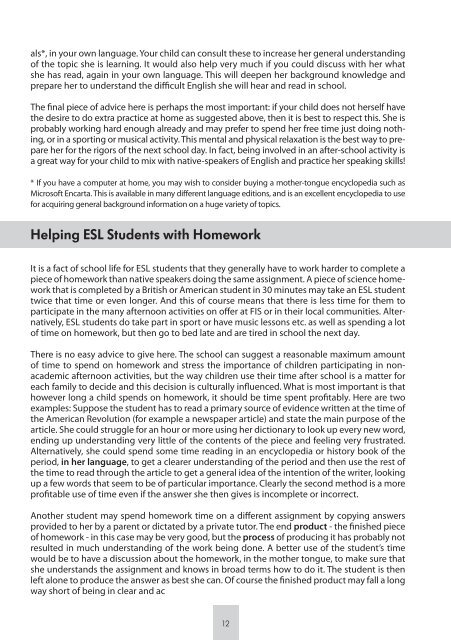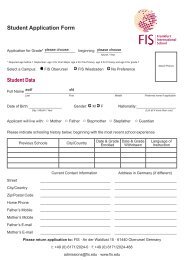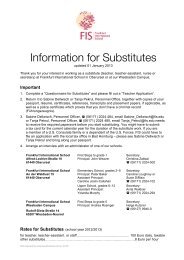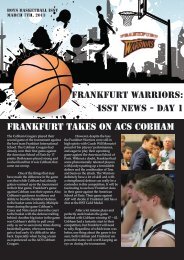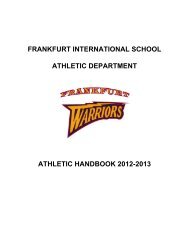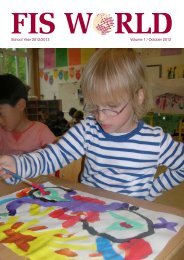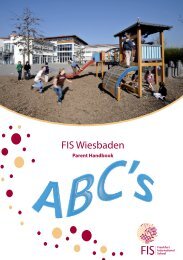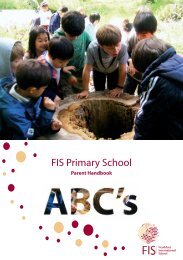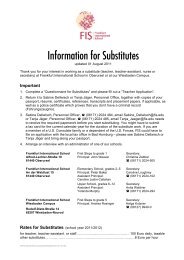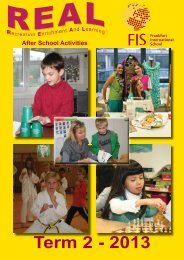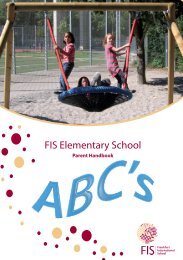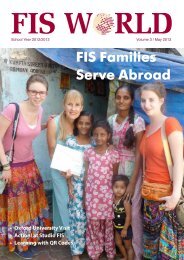English as a Second Language - Frankfurt International School
English as a Second Language - Frankfurt International School
English as a Second Language - Frankfurt International School
Create successful ePaper yourself
Turn your PDF publications into a flip-book with our unique Google optimized e-Paper software.
als*, in your own language. Your child can consult these to incre<strong>as</strong>e her general understanding<br />
of the topic she is learning. It would also help very much if you could discuss with her what<br />
she h<strong>as</strong> read, again in your own language. This will deepen her background knowledge and<br />
prepare her to understand the difficult <strong>English</strong> she will hear and read in school.<br />
The final piece of advice here is perhaps the most important: if your child does not herself have<br />
the desire to do extra practice at home <strong>as</strong> suggested above, then it is best to respect this. She is<br />
probably working hard enough already and may prefer to spend her free time just doing nothing,<br />
or in a sporting or musical activity. This mental and physical relaxation is the best way to prepare<br />
her for the rigors of the next school day. In fact, being involved in an after-school activity is<br />
a great way for your child to mix with native-speakers of <strong>English</strong> and practice her speaking skills!<br />
* If you have a computer at home, you may wish to consider buying a mother-tongue encyclopedia such <strong>as</strong><br />
Microsoft Encarta. This is available in many different language editions, and is an excellent encyclopedia to use<br />
for acquiring general background information on a huge variety of topics.<br />
Helping ESL Students with Homework<br />
It is a fact of school life for ESL students that they generally have to work harder to complete a<br />
piece of homework than native speakers doing the same <strong>as</strong>signment. A piece of science homework<br />
that is completed by a British or American student in 30 minutes may take an ESL student<br />
twice that time or even longer. And this of course means that there is less time for them to<br />
participate in the many afternoon activities on offer at FIS or in their local communities. Alternatively,<br />
ESL students do take part in sport or have music lessons etc. <strong>as</strong> well <strong>as</strong> spending a lot<br />
of time on homework, but then go to bed late and are tired in school the next day.<br />
There is no e<strong>as</strong>y advice to give here. The school can suggest a re<strong>as</strong>onable maximum amount<br />
of time to spend on homework and stress the importance of children participating in nonacademic<br />
afternoon activities, but the way children use their time after school is a matter for<br />
each family to decide and this decision is culturally influenced. What is most important is that<br />
however long a child spends on homework, it should be time spent profitably. Here are two<br />
examples: Suppose the student h<strong>as</strong> to read a primary source of evidence written at the time of<br />
the American Revolution (for example a newspaper article) and state the main purpose of the<br />
article. She could struggle for an hour or more using her dictionary to look up every new word,<br />
ending up understanding very little of the contents of the piece and feeling very frustrated.<br />
Alternatively, she could spend some time reading in an encyclopedia or history book of the<br />
period, in her language, to get a clearer understanding of the period and then use the rest of<br />
the time to read through the article to get a general idea of the intention of the writer, looking<br />
up a few words that seem to be of particular importance. Clearly the second method is a more<br />
profitable use of time even if the answer she then gives is incomplete or incorrect.<br />
Another student may spend homework time on a different <strong>as</strong>signment by copying answers<br />
provided to her by a parent or dictated by a private tutor. The end product - the finished piece<br />
of homework - in this c<strong>as</strong>e may be very good, but the process of producing it h<strong>as</strong> probably not<br />
resulted in much understanding of the work being done. A better use of the student’s time<br />
would be to have a discussion about the homework, in the mother tongue, to make sure that<br />
she understands the <strong>as</strong>signment and knows in broad terms how to do it. The student is then<br />
left alone to produce the answer <strong>as</strong> best she can. Of course the finished product may fall a long<br />
way short of being in clear and ac<br />
12


